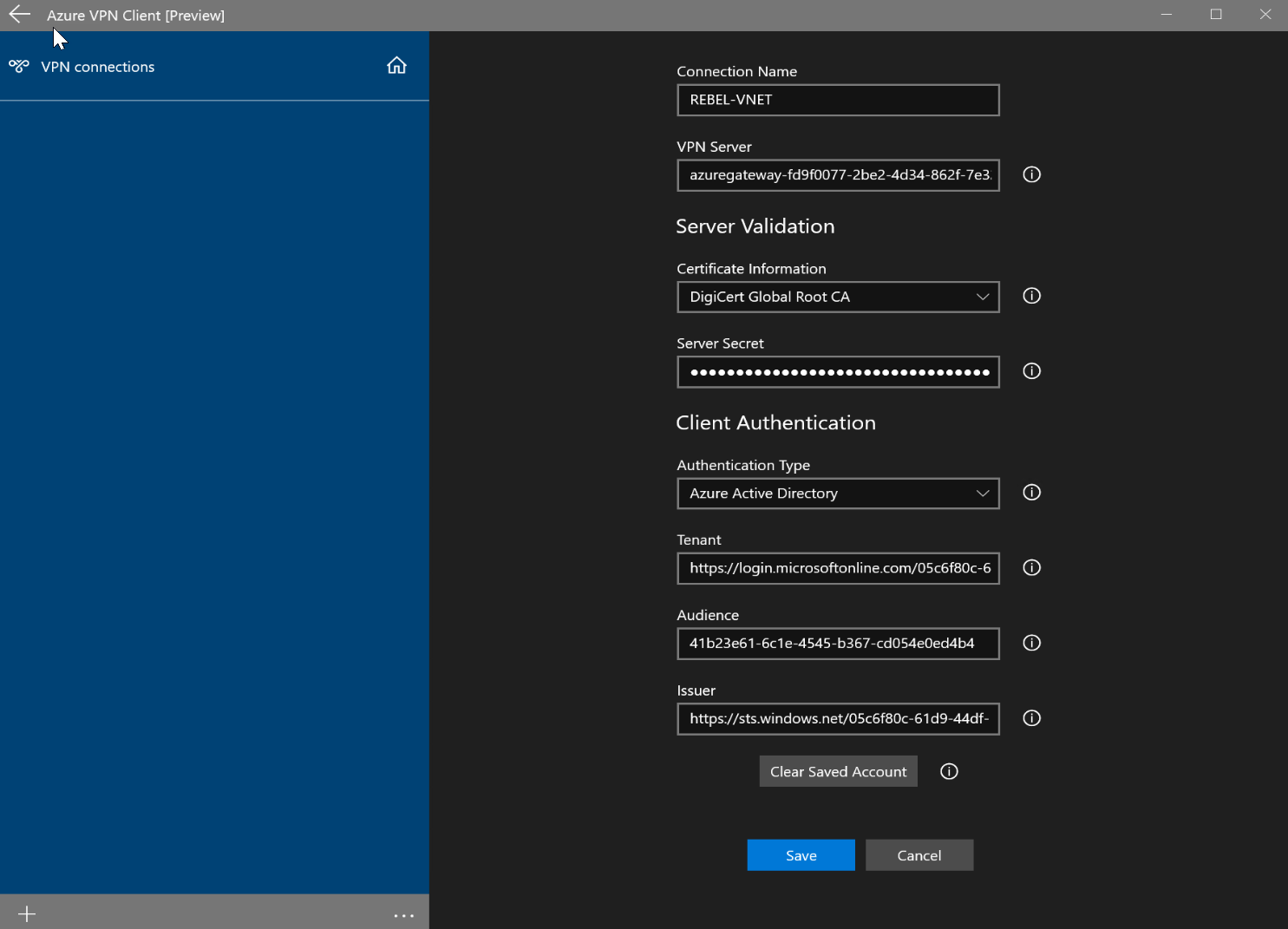

It is manual process and there is no way to automate it. Here is where things fall apart, how do you control the VPN Client Azure gave you to connect to Azure, you do not. Once you can ping your Azure VM your good to move on If you never use it that is fine but it is best to have it ready if you need it in the future Also saw this one, Event 1058 Account does not exist, if you have other Events something is wrong with your Domain or network setup, ours was pristine as verified by Microsoft Engineers we worked with.įirst thing is to setup your Azure Network to support Point-Site Client VPN, also you will want to setup Site-Site capabilities as doing this later may prove difficult.
AZURE VPN CLIENT UPDATE
If you need proof try searching for this error: SMBClient/Security Event ID 31001 we had an entry for every time the System made an attempt to update Group Policy. Search as you will but this is nowhere to be found on the Web or on TechNet as of the time this article was written. If that is acceptable then great, however this was not an acceptable outcome for us! WSI spent countless hours on the phone with different Microsoft Engineers and finally found the fix. Once all was setup we discovered a very strange issue, our clients would do a Group Policy update (GPupdate) for only ten minutes after logon, then the User Policy would apply but not the Computer Policy. These are roaming users with no connectivity to the Domain outside the VPN connection.
AZURE VPN CLIENT PRO
Our testing environment consisted of two Microsoft Active Directory Domain Controllers running on Microsoft Azure with 80+ Win 8.1 Pro machines connected to the Domain.

Thank you to the other talented people who have already written on this topic. This article will build upon the work of others whose information WSI studied, that helped us come up with this solution. If you would like assistance implementing this solution for you or along with you please contact us today to get our rates and schedule the assistance. All we ask is that you take a moment to see if any of the services we offer might benefit you. If you find this information useful and it solves this problem for you that is great. If you are joining us via a search result Bing, Google or another search engine welcome to our website. Note: Ensure that your Azure Network security groups do not prevent access from the remote networks behind your NG Firewall.(Azure says it can’t be done but we did it)ĭiscover the hidden setting that makes Azure Client VPN Automated work on a Domain Joined Machine If the local network configuration is correct, you can ping between hosts on the internal networks. If the tunnels connect, the status shows Connected (Azure) or Active (NG Firewall). Shared Secret : The shared key value you entered into the Azure VPN Connection.Īfter you configure the tunnel on both gateways you can view the connection status. Remote Network : The remote subnets in your Azure virtual network that you want to add to the VPN tunnel Local Network : The local subnets you want to add to the VPN tunnel Remote Identifier : The Internet IP address of your Azure VPN Gateway Local Identifier : The Internet IP address of your NG Firewall host Remote Host : The Internet IP address of your Azure VPN Gateway In the IPsec Tunnels tab, click add to configure a tunnel with your Azure VPN Gateway. Shared key (PSK) : Enter a private key that must be shared with the remote IPsec gateway. Local network gateway: Select the Local network gateway you created in the previous step. Virtual network gateway: Select the Virtual network gateway you created in the first step. In the virtual network gateway settings, go to Connections and add a connection. IP address: The Internet IP address of your NG Firewall gateway.Īddress space: The local subnet behind your NG Firewall that you want to participate in the VPN tunnel.Ī connection sets up the tunnel with your remote Untangle NG Firewall. Name: A name to help you identify the tunnel endpoint. This resource represents the NG Firewall side of the VPN tunnel. In your Azure Management Portal create a Local Network Gateway type of resource. This IP address is the Azure endpoint of the VPN tunnel. Public IP address: Select an existing public IP address or create one. Gateway subnet address range: Select the subnet in your Azure virtual network that you want to participate in the VPN tunnel. Virtual network : Select an existing network or create one This resource represents the Azure side of the VPN tunnel.Ĭonfigure the following essential parameters: In your Azure Management Portal create a Virtual Network Gateway type of resource. This article describes configuring an IPsec tunnel using IKEv2 between NG Firewall and the Azure VPN Gateway. This is possible using either the Azure VPN Gateway or the NG Firewall for Azure public cloud. You can connect your NG Firewall networks to your Microsoft Azure networks using IPsec VPN tunnels.


 0 kommentar(er)
0 kommentar(er)
